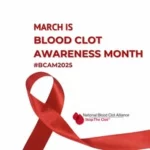Travel and Blood Clots
Preventing Travel-Related Blood Clots: A Passport to Safety
As holidays or vacation time approaches, it is never too early to think about protecting yourself from the risk of blood clots—deep vein thrombosis (DVT) and pulmonary embolism (PE)—when you travel for more than four hours by plane, train, car or bus.
The National Blood Clot Alliance has published a one-page Passport to Safety that provides a common-sense guide to what you need to know to prevent blood clots when you are traveling for long distances.
In-Flight Fitness
Don’t let cramped conditions put you at risk for blood clots—including deep vein thrombosis (DVT) and pulmonary embolism (PE). Keep your body moving, even when traveling by airplane, or seated in a car, bus or train: In-Flight and Seated Fitness Tips
Additional Resources
Mini PEP Talk: Holiday Travel Tips for VTE Prevention
As holidays or vacation time approaches, it is never too early to think about protecting yourself from the risk of blood clots when you travel. Learn travel tips from fellow blood clot patients who think about this every day – NBCA President Leslie Lake & Board member, Todd Robertson.




